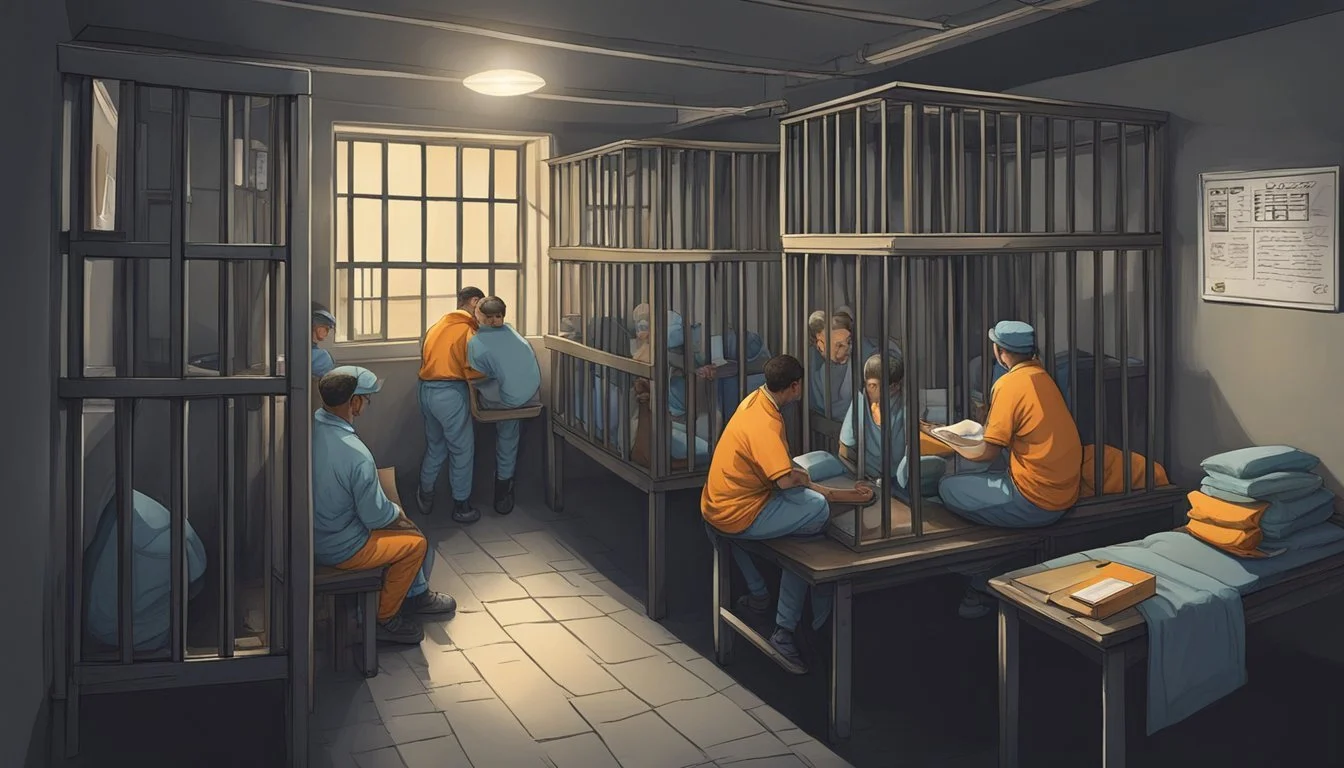Donald Gaskins Meets His Maker: Meanest Man in America's Death Row Diary Reveals Final Thoughts
Donald Henry Gaskins, infamously known as "The Meanest Man in America," left a trail of terror across South Carolina. Standing at just 5'4", this diminutive serial killer earned his chilling moniker through a series of brutal murders that shocked the nation. Gaskins' reign of terror came to an end in 1991 when he was executed by electric chair, but not before he attempted to cheat death one final time.
Dubbed "Pee Wee" due to his small stature, Gaskins' criminal career spanned decades. He stabbed, shot, drowned, and poisoned over a dozen victims, leaving a wake of devastation in his path. His time on death row was marked by further violence, including the shocking murder of a fellow inmate in 1982.
The final chapter of Gaskins' life unfolded on death row, where he spent his last years under strict supervision. Despite the rigid confines of prison life, Gaskins managed to maintain his reputation for brutality until the very end. His death row diary offers a chilling glimpse into the mind of one of America's most notorious killers.
The Early Years: A Troubled Childhood
Donald Gaskins' path to becoming "The Meanest Man in America" began with a harrowing childhood marked by abuse, neglect, and early exposure to violence. His formative years set the stage for a life of crime and brutality.
Reform School and Early Criminal Behavior
Born in 1933 in Florence County, South Carolina, Donald Gaskins faced a harsh upbringing. He endured physical abuse from his stepfather and struggled in school due to learning difficulties. At age 11, Gaskins was sent to reform school after a violent incident with a young girl.
In reform school, Gaskins experienced further abuse and exploitation. He became known as "Pee Wee" due to his small stature. This environment fostered his criminal tendencies and exposed him to more violent behavior.
After his release, Gaskins continued his criminal activities. He committed various crimes, including theft and assault. His actions escalated, leading to more serious offenses and repeat incarcerations.
The Trouble Trio and Escalation of Violence
In his late teens, Gaskins formed a group called the "Trouble Trio" with two other young men. This alliance marked a turning point in his criminal career. The group engaged in burglaries, assaults, and other violent acts across South Carolina.
Their crimes grew increasingly brutal. Gaskins' propensity for violence became more apparent during this period. He showed little remorse for his actions and seemed to revel in causing harm to others.
The Trouble Trio's activities eventually led to Gaskins' imprisonment for attempted murder. This incarceration would be a pivotal moment, further hardening his criminal resolve and setting the stage for his future as a serial killer.
Path to Infamy: Beginnings of a Serial Killer
Donald Henry "Pee Wee" Gaskins Jr. embarked on his murderous spree in the 1960s. His criminal activities escalated from petty crimes to brutal killings, earning him the notorious title of "The Meanest Man in America."
First Known Victims and Kidnapping
Gaskins' violent tendencies manifested early in his life. His first known victims were two young girls he kidnapped in 1969. He raped and tortured them before releasing them alive. This incident marked the beginning of his descent into more heinous crimes.
Gaskins soon progressed to murder. He killed his first victim, a hitchhiker, in September 1969. This act ignited a twisted desire within him, leading to a series of brutal slayings.
Doreen Dempsey and Ill-Fated Hitchhikers
In 1971, Gaskins committed one of his most shocking crimes. He murdered Doreen Dempsey, a pregnant woman, and her two-year-old daughter. This horrific act demonstrated his complete disregard for human life.
Gaskins targeted hitchhikers frequently. He picked up unsuspecting travelers along coastal highways, offering them rides. Many of these encounters ended in brutal murders.
His victims included both men and women. Gaskins showed no discrimination in his choice of targets. He often tortured his victims before killing them, displaying a level of cruelty that shocked even hardened law enforcement officers.
Brutal Crimes and Mutilation
Donald Gaskins earned his nickname "The Meanest Man in America" through a series of brutal murders and mutilations. His crimes were marked by extreme violence, torture, and a callous disregard for human life.
Torture Techniques and Coastal Kills
Gaskins developed a sadistic repertoire of torture methods. He often used pliers, piano wire, and ice picks on his victims. His "coastal kills" involved picking up hitchhikers or luring victims to isolated areas.
Gaskins claimed to have committed at least 10 coastal kills by October 1970. These murders were characterized by prolonged torture sessions lasting up to a week. He took pleasure in gradually increasing the pain and suffering of his victims.
Rampage and Serious Murders
In 1970, Gaskins escalated his violence with the murder of 13-year-old Peggy Cuttino. This crime went unsolved for years, with another man wrongly blamed. Gaskins didn't confess until 1977.
His murderous spree continued unabated. He killed both strangers and acquaintances, including:
Diane Neely and her boyfriend (attempted blackmailers)
Two of his own nieces
A pregnant woman
Gaskins showed no remorse for these killings, viewing his victims as objects for his twisted desires.
Kidnapping and Mutilation
Gaskins often kidnapped his victims, holding them captive for extended periods. He would meticulously plan these abductions, ensuring he had ample time to carry out his gruesome acts.
His mutilation practices were particularly horrific:
Cannibalism of body parts
Dismemberment of corpses
Preservation of body parts as trophies
Gaskins reportedly ate the flesh of some victims, claiming it gave him a sense of power. He disposed of remains in various ways, including burying them in remote locations and dumping them in swamps.
The Legal Battles: Trials and Sentences
Donald Gaskins faced multiple trials and sentences throughout his criminal career. His legal battles culminated in life sentences and eventually the death penalty.
Life Sentences and the Electric Chair
Gaskins received his first life sentence in 1976 for the murder of Dennis Bellamy. He was convicted of six additional murders in 1977, resulting in seven consecutive life terms.
In 1982, Gaskins was sentenced to death for killing a fellow inmate, Rudolph Tyner. This marked the first time in South Carolina's history that a white man received the death penalty for killing a black man.
Gaskins' execution was scheduled to take place in the electric chair. The method of execution added to the notoriety surrounding his case.
From Parole to Death Penalty
Prior to his final convictions, Gaskins had been paroled multiple times. His release in 1969 led to a series of brutal murders that ultimately sealed his fate.
Gaskins' attempts to delay his execution included confessing to additional murders. However, these efforts proved futile.
The courts upheld Gaskins' death sentence despite appeals. His execution date was set for September 6, 1991, at South Carolina's Central Correctional Institution.
Gaskins' journey from repeated paroles to death row exemplified the judicial system's evolving approach to violent offenders.
Death Row: Donald Gaskins' Final Chapter
Donald Gaskins spent his final years on death row, making legal appeals and engaging in shocking acts of violence. His execution in 1991 marked the end of his reign of terror.
Attempts at Legal Reform and Appeals
Gaskins pursued several legal avenues to avoid execution after his conviction. He filed appeals challenging the constitutionality of the death penalty. His lawyers argued that executing him would violate the Eighth Amendment's prohibition on cruel and unusual punishment.
Gaskins also sought clemency from the governor, claiming he had found religion in prison. He wrote letters to anti-death penalty groups, trying to gain support for his cause. Despite these efforts, all of Gaskins' appeals were ultimately rejected by the courts.
Communications with Rudolph Tyner
While on death row, Gaskins formed an unusual relationship with fellow inmate Rudolph Tyner. Tyner had been convicted of killing an elderly couple during a robbery.
Gaskins offered to help Tyner file appeals. However, this was a ruse. Gaskins was actually hired by the elderly couple's son to kill Tyner. He constructed a makeshift explosive device and convinced Tyner to hold it up to his ear, claiming it was a communication device. The explosion killed Tyner instantly.
This murder-for-hire scheme led to an additional death sentence for Gaskins.
The Execution and its Aftermath
On September 6, 1991, Gaskins was scheduled for execution by electric chair. Hours before, he attempted suicide by slashing his wrists with a razor blade. Prison staff discovered him in time and he received medical treatment.
At 1:10 AM, Gaskins was strapped into the electric chair. His last words were: "I'll let my lawyers talk for me. I'm ready to go." The execution was carried out as planned.
Gaskins' death marked the end of his murderous legacy. He had confessed to killing 13 people, though he claimed to have murdered over 100. His execution brought a sense of closure to the families of his many victims.
Life After Death: Gaskins' Culture Impact
Donald Gaskins' legacy persisted long after his execution, influencing various aspects of true crime culture and criminal studies.
Memoirs and Autobiography
Gaskins co-authored his autobiography, "Final Truth," with Wilton Earle. Published in 1992, the book provided chilling insights into his crimes and mindset. It became a controversial bestseller, offering readers a disturbing glimpse into the mind of a serial killer.
The memoir sparked debates about the ethics of publishing criminals' accounts. Critics argued it glorified violence, while others saw it as a valuable psychological resource.
"Final Truth" remains a significant work in true crime literature, often cited in discussions about serial killers' motivations and thought processes.
Documentaries and True Crime Fascination
Gaskins' case has been featured in numerous true crime documentaries and television series. These productions explore his troubled childhood, criminal career, and eventual capture.
Notable documentaries include:
"Born to Kill?: Donald Gaskins"
"Evil Lives Here: The Meanest Man in America"
These programs analyze Gaskins' crimes, interviewing law enforcement officers, victims' families, and criminal psychologists. They contribute to the ongoing public fascination with serial killers and their psychology.
The coverage of Gaskins' case in media has sparked discussions about the ethics of true crime entertainment and its impact on victims' families.
Psychological Analysis and Criminal Studies
Gaskins' case has become a subject of study in criminal psychology and forensic science. Researchers analyze his behavior patterns, childhood trauma, and criminal motivations to gain insights into the psychology of serial killers.
Key areas of study include:
Impact of childhood abuse on criminal behavior
Patterns of escalation in violent crimes
Psychopathic traits and lack of empathy
Criminal justice programs often use Gaskins' case as a teaching tool. It helps students understand the complexities of serial killer investigations and the importance of psychological profiling.
The study of Gaskins' crimes has contributed to advancements in criminal profiling techniques and the understanding of violent criminal behavior.
Prison Life and Interactions with Inmates
Donald Gaskins adapted to prison life through criminal activities and intimidation. He clashed with officials and inmates alike, gaining a reputation among other notorious killers.
Daily Realities and Criminal Activities
Gaskins quickly learned to navigate the harsh prison environment. He engaged in various illicit activities to maintain power and influence. These included smuggling contraband, orchestrating protection rackets, and even continuing his violent tendencies behind bars.
Gaskins' small stature earned him the nickname "Pee Wee," but he compensated with cunning and brutality. He formed alliances with other inmates to strengthen his position and protect himself from potential threats.
Despite tight security measures, Gaskins managed to acquire weapons and drugs. He used these to assert dominance and carry out his criminal enterprises within the prison walls.
Conflict with Prison Officials and Inmates
Gaskins frequently clashed with prison authorities. He resisted rules and regulations, often resulting in disciplinary actions. His defiant attitude led to extended periods in solitary confinement.
Confrontations with other inmates were common. Gaskins' reputation as "the meanest man in America" made him both feared and targeted. He fought to maintain his status, engaging in violent altercations with those who challenged him.
Guards remained vigilant due to Gaskins' history of escape attempts and continued criminal behavior. This constant surveillance created additional tension between Gaskins and prison staff.
The Notoriety among Other Notorious Serial Killers
Gaskins gained infamy among his fellow inmates, particularly other serial killers. His brutal crimes and unrepentant attitude earned him a mix of respect and fear.
He corresponded with other notorious killers, exchanging stories and methods. This network of communication further solidified his status within the prison hierarchy.
Some inmates sought Gaskins' advice on survival tactics, while others kept their distance. His reputation extended beyond prison walls, attracting media attention and true crime enthusiasts.
The Echo of Gaskins: Legacy and Remembering the Victims
Donald Gaskins' reign of terror left an indelible mark on society. His crimes sparked changes in law enforcement and prison security, while also highlighting the importance of honoring victims.
Tributes and Remembrance of Victims
Families of Gaskins' victims have worked tirelessly to ensure their loved ones are not forgotten. Annual memorial services are held in South Carolina to honor those who lost their lives.
Local communities have erected monuments and plaques bearing the names of the victims. These serve as solemn reminders of the lives cut short by Gaskins' brutality.
Support groups for survivors and families emerged in the wake of Gaskins' crimes. These organizations provide counseling and advocate for victims' rights.
Some families have established scholarships in memory of their lost loved ones. These educational funds aim to create positive legacies from tragedy.
Legal and Correctional System Reflection
Gaskins' crimes exposed weaknesses in correctional facility security. Prisons implemented stricter protocols for high-risk inmates after his escape attempts and in-prison murder.
Law enforcement agencies revamped their procedures for investigating missing persons cases. This change aimed to improve response times and potentially save lives.
The justice system faced scrutiny over how Gaskins evaded capture for so long. This led to improved coordination between jurisdictions when tracking suspected serial killers.
Gaskins' case influenced debates on capital punishment. Advocates pointed to his crimes as justification for the death penalty, while opponents highlighted the cost and length of appeals.






